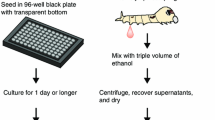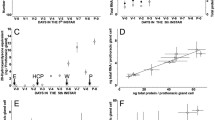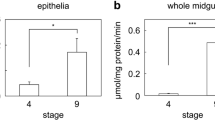Summary
Brains and subesophageal ganglia from day 3.5 fifth stadium larvae of Manduca sexta were incubated in vitro with 4 nM tritiated ponasterone A, a 20-hydroxyecdysone analog, to determine whether uptake and specific binding of ecdysteroids occur at a cellular level. These tissues, which were taken just prior to the commitment peak in the hemolymph-ecdysteroid titer, showed saturable uptake of 3H-ponasterone A after 40–60 min of incubation. Uptake was blocked by the addition of 400 nM unlabelled ponasterone A, or of 500 nM or 1000 nM 20-hydroxyecdysone. RH 5849, a synthetic 20-hydroxyecdysone agonist with a long half-life, for which ecdysteroid receptors have low affinity, also reduced ponasterone A uptake at a concentration of 10 μM. Autoradiographs of 4 μm sections of brains revealed distinct nuclear concentrations of silver grains over cell populations in the pars intercerebralis, pars lateralis, and ventral tritocerebrum. Nuclear labelling was also found in many small cells around the mushroom bodies and the neuropil, and between the inner and outer larval optic lobes. Nuclear labelling of cells in the subesophageal ganglion was observed in the fronto-medial and lateral regions, in small cells around the neuropil, and caudally in a few large neurons. In addition to cells with nuclear labelling, both brains and ganglia at this development stage contained cells with exclusively cytoplasmic or both nuclear and cytoplasmic labelling. None of these apparent binding sites were observed in the competition experiments, suggesting that the binding is specific.
Similar content being viewed by others
References
Altman JS, Kien J (1987) Functional organization of the subesophageal ganglion. In: Gupta AP (ed) Arthropod brain: Its evolution, development, structure, and functions. Wiley, New York, pp 265–302
Beckers Ch, Maroy P, O'Connor JD, Emmerich H (1980) Uptake and release of 3H-ponasterone A by the Kc cell line of Drosophila melanogaster. In: Hoffmann JA (ed) Progress in Ecdysone Research. Elsevier/North Holland Biomedical Press, Amsterdam, New York, pp 335–347
Beenakkers AMT, Horst DJ van der, Marrewijk WJA van (1978) Regulation of release and metabolic function of the adipokinetic hormone in insects. In: Gaillard PJ, Boer HH (eds) Comparative endocrinology. Elsevier, Amsterdam
Bell RA, Joachim FG (1976) Techniques for rearing laboratory colonies of tobacco hornworms and pink bollworms. Ann Entomol Soc Am 69:365–373
Beydon P, Lafont R (1983) Feedback inhibition of ecdysone production by 20-hydroxyecdysone in Pieris brassicae pupae. J Insect Physiol 29:529–533
Bidmon H-J (1988) Untersuchungen zur Ecdysonsynthese und Ecdysteroid-Rezeptor-Localisation in Calliphora vicina-Larven und einigen anderen Evertebraten. PhD Dissertation FB 15 Biologie, Justus-Liebig University, Giessen (FRG) pp 1–249
Bidmon H-J, Sliter TJ (1990) The ecdysteroid receptor. Int J Invert Reprod Dev 18:13–27
Bidmon H-J, Seifert G, Koolman J (1987) Lokalisation von Ecdysteroiden und ihren Rezeptoren in Evertebraten. Verh Dtsch Zool Ges 80:157–158
Bidmon H-J, Stumpf WE, Granger NA (1990) Uptake and binding of ponasterone A in the brain of fifth stadium Manduca sexta larvae. In: Borkovec AB, Kelly TJ (eds) Insect Neurochemistry and Neurophysiology, Plenum Press, NJ, pp 405–408
Birkenbeil H, Eckert M, Gersch M (1979) Electron microscopical and immunocytochemical evidence of ecdysteroids in the prothoracic gland of Galleria mellonella. Cell Tissue Res 200:285–290
Bollenbacher WE, Smith SL, Goodman W, Gilbert LI (1981) Ecdysteroid titer during larval-pupal-adult development of the tobacco hornworm, Manduca sexta. Gen Comp Endocrinol 44:302–306
Canonica L, Danieli B, Lesma G, Palmisano G (1985) Unusual photochemical behavior of the enone chromophore of the insect moulting hormone 20-α-hydroxyecdysone. J Chem Soc Chem Commun 703:1321–1322
Carlson SD (1987) Ultrastructure of the arthropod neuroglia and neuropil. In: Gupta AP (ed) Arthropod brain: Its evolution, development, structure and functions. Wiley, New York, pp 323–346
Clever U, Karlson P (1960) Induktion von Puff-Veränderungen in den Speicheldrüsenchromosomen von Chironomus tentans durch Ecdysone. Exp Cell Res 20:623–626
Copenhaver PF, Truman JW (1986a) Metamorphosis of the central neuroendocrine system in the moth Manduca sexta. J Comp Neurol 249:136–201
Copenhaver PF, Truman JW (1986b) Identification of cerebral neurosecretory cells that contain eclosion hormone in the moth Manduca sexta. J Neurosci 6:1738–1747
Deak P, Zavorszky P, Maroy P (1988) Moulting hormone regulates its receptor level in Drosophila melanogaster. Insect Biochem 18:847–852
Dominik OS, Truman JW (1985) The physiology of wandering behaviour in Manduca sexta. II. The endocrine control of wandering behaviour. J Exp Biol 117:45–68
Emmerich H (1969) Distribution of tritiated ecdysone in salivary gland cells of Drosophila. Nature 221:954–955
Fahrbach SE, Truman WE (1989) Autoradiographic identification of ecdysteroid-binding cells in the nervous system of the moth Manduca sexta. J Neurobiol 20:681–702
Fuxe F, Wikstrom AC, Okret S, Agnati LF, Harfstrand A, Yu ZY, Granholm L, Zoli M, Gustafsson JA (1985) Mapping of glucocorticoid receptor immunoreactivite neurons in the rat tel-and diencephalon using a monoclonal antibody against rat liver glucocorticoid receptor. Endocrinology 117:1803–1812
Glass H, Emmerich H, Spindler K-D (1978) Immunohistochemical localisation of ecdysteroids in the follicular epithelium of locust oocytes. Cell Tissue Res 194:237–244
Granger NA, Whisenton LR, Janzen WP, Bollenbacher WE (1987) Interendocrine control by 20-hydroxyecdysone of the corpora allata of Manduca sexta. Insect Biochem 17:949–953
Gronemeyer H, Pongs O (1980) Localization of ecdysterone on polytene chromosomes of Drosophila melanogaster. Proc Natl Acad Sci USA 77:2108–2112
Guiochon-Mantel A, Loosfelt H, Lescop P, Sar S, Atger M, Perrot-Applanat M, Milgrom E (1989) Mechanism of nuclear localization of the progesterone receptor: Evidence for interaction between monomers. Cell 57:1147–1154
Horodyski FM, Riddiford LM, Truman JW (1989) Isolation and expression of the eclosion hormone gene from the tobacco hornworm, Manduca sexta. Proc Natl Acad Sci USA 86:8123–8127
Jensen EV, Suzuki T, Kawashima T, Stumpf WE, Jungblut PW, DeSonbre ER (1968) A two-step mechanism for the interaction of oestradiol with rat uterus. Proc Natl Acad Sci USA 59:632–638
Lehmann M, Koolman J (1988) Ecdysteroid receptors of the blowfly Calliphora vicina: partial purification and characterization of ecdysteroid binding. mol Cell Endocrinol 57:239–249
Levine RB (1989) Expansion of the central arborizations of persistent sensory neurons during insect metamorphosis: The role of the steroid hormone, 20-hydroxyecdysone. J Neurosci 9:1045–1054
Lezzi M, Gatzka F, Robert-Nicoud M (1989) Developmental changes in the responsiveness of ecdysterone of chromosome region I-18C of Chironomus tentans. Chromosoma 98:23–32
Loeb MJ (1986) Ecdysteroids in testis sheats of Heliothis virescens larvae: An immunocytological study. Arch Insect Biochem Physiol 3:173–180
Maroy P, Dennis R, Beckers C, Sage B, O'Connor J (1978) Demonstration of an ecdysteroid receptor in a cultured cell line of Drosophila melanogaster. Proc Natl Acad Sci USA 75:6035–6038
Orchard I, Lange AB, Ramirez J-M (1989) Serotonin-like immunoreactiv dorsal unpaired median neurons in Rhodnius prolixus. 3rd Intern. Conf. Insect Neurochem. Neurophysiology, [Abstract) 7:23, University of Maryland, USA
Pipa RL (1969) Insect neurometamorphosis: IV. Effects of the brain and synthetic-ecdysone upon interganglionic connective shortening in Galleria mellonella. J Exp Biol 170:181–192
Sage BA, Horn DHS, Landon TM, O'Connor JD (1986) Alternative ligands for measurement and purification of ecdysteroid receptors in Drosophila Kc-cells. Arch Insect Biochem Physiol [Suppl] 1:25–33
Schürmann FW (1987) The architecture of the mushroom bodies and related neuropils in the insect brain. In: Gupta AP (ed) Arthropod brain: Its evolution, development, structure and functions. Wiley, New York, pp 231–264
Schwartz LM (1986) Endocrine regulation of terminal muscle differentiation. Atrophy and degeneration of the intersegmental muscles of lepidoptera. J Insect Biochem 16:203–209
Spindler K-D, Spindler-Barth M (1989) Uptake of ecdysteroids. In: Koolman J (ed) Ecdysone. Thieme, Stuttgart New York, pp 245–249
Stumpf WE (1976) Techniques for the autoradiography of diffusible compounds. In: Prescott DM (ed) Methods in Cell Biology XIII. Academic Press, New York, pp 171–193
Stumpf WE (1984) Histochemical characteristics and significance of cell receptors in biology and pathology. Acta Histochem [Suppl] 29:23–33
Stumpf WE, Grant LD (eds) (1975) Anatomical Neuroendocrinology. Karger, Basel
Stumpf WE, Sar M, Zuber TJ, Soini E, Tuohimaa P (1981) Quantitative assessment of steroid hormone binding sites by thawmount autoradiography. J Histochem Cytochem 29:201–206
Thompson S, Radde L, Farley DB, Rosazza JP, Van Orden DE (1985) Immunocytochemical localization of tissue-bound oestradiol in rat paracervical ganglion. Histochem J 17:493–506
Thomson JA, Rogers DC, Gunson MM, Horn DHS (1970) Developmental changes in the pattern of cellular distribution of exogenous tritium-labelled crustecdysone in larval tissues of Calliphora. Cytobios 6:78–88
Treherne JE, Pichon Y (1972) The insect blood-brain barrier. In: Treherne JE, Berridge MJ, Wigglesworth VB (eds) Advances in insect physiology. Academic Press, London, pp 257–312
Truman JW, Reiss SE (1988) Hormonal regulation of the shape of identified motoneurones in the moth Manduca sexta. J Neurosci 8:765–775
Vince RK, Gilbert LI (1977) Juvenile hormone esterase activity in precisely timed last instar larvae and pharate pupae of Manduca sexta. Insect Biochem 7:115–120
Watson RD, Spaziani E, Bollenbacher WE (1989) Regulation of ecdysone biosynthesis in insects and crustaceans: a comparison. In: Koolman J (ed) Ecdysone. Thieme, Stuttgart New York, pp 188–203
Watson RD, Whisenton LR, Bollenbacher WE, Granger NA (1986) Interendocrine regulation of the corpora allata and prothoracic glands of Manduca sexta. Insect Biochem 16:149–155
Wing KD (1988) RH 5849, a nonsteroidal ecdysone agonist: effects on a Drosophila cell line. Science 241:467–469
Wing KD (1989) Recent findings on the nonsteroidal ecdysone mimic, RH 5849. Proceedings IX. ecdysone workshop, September 11–14 Paris, France
Wolfgang WJ, Riddiford LM (1986) Larval cuticular morphogenesis in the tobacco hornworm, Manduca sexta, and its hormonal regulation. Dev Biol 113:305–316
Yund MA, Osterbur DL (1985) Ecdysteroid receptors and binding proteins. In: Kerkut GA, Gilbert LI (eds) Comprehensive Insect Physiology, Biochemistry and Pharmacology. Pergamon Press, Oxford, pp 473–490
Yund MA, King DS, Fristrom JW (1978) Ecdysteroid receptors in imaginal discs of Drosophila melanogaster. Proc Natl Acad Sci USA 75:6039–6043
Author information
Authors and Affiliations
Rights and permissions
About this article
Cite this article
Bidmon, H.J., Stumpf, W.E. & Granger, N.A. Ecdysteroid binding sites localized by autoradiography in the central nervous system of precommitment fifth-stadium Manduca sexta larvae. Cell Tissue Res 263, 183–194 (1991). https://doi.org/10.1007/BF00318414
Accepted:
Issue Date:
DOI: https://doi.org/10.1007/BF00318414




